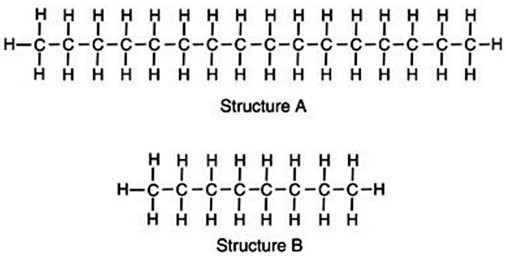Oceans
A) cover nearly half the Earth's surface.
B) have likely slowed atmospheric warming over the last 50 or so years.
C) have fixed circulation patterns that do not change.
D) have little effect on the atmosphere.
E) definitely contribute to global warming.
B
You might also like to view...
Two chemical structures are shown, one of a typical gasoline molecule and the other of a typical motor oil molecule. Which is which? Base your reasoning not on memorization but rather upon what you know about molecular interactions and the various physical properties of gasoline and motor oil.
Base your reasoning not on memorization but rather upon what you know about molecular interactions and the various physical properties of gasoline and motor oil.
A. Structure A represents the gas molecule because there are more bonds to gain energy from, giving it a higher energy content than oil. B. Structure B represents crude oil which is processed to generate longer molecules of gasoline to prevent toxic vapors from harming consumers. C. Structure B represents the oil molecule. Because oil molecules are smaller, they can compact closer together, giving the appearance of a thicker solution than gasoline. D. Structure A represents motor oil, illustrating a molecule with greater induced dipole-induced dipole molecular interactions; thus, the molecules are strongly attracted to one another.
Explain why most materials become less dense as their temperature is increased?
What will be an ideal response?
Mosses, lichens, and short grasses are the common types of natural vegetation in a:
a. taiga. b. tundra. c. savanna. d. chaparral.
The San Andreas Fault system can be described as ________.
A. thrust dip-slip B. right lateral strike-slip C. left lateral strike-slip D. normal dip-slip E. reverse oblique-slip